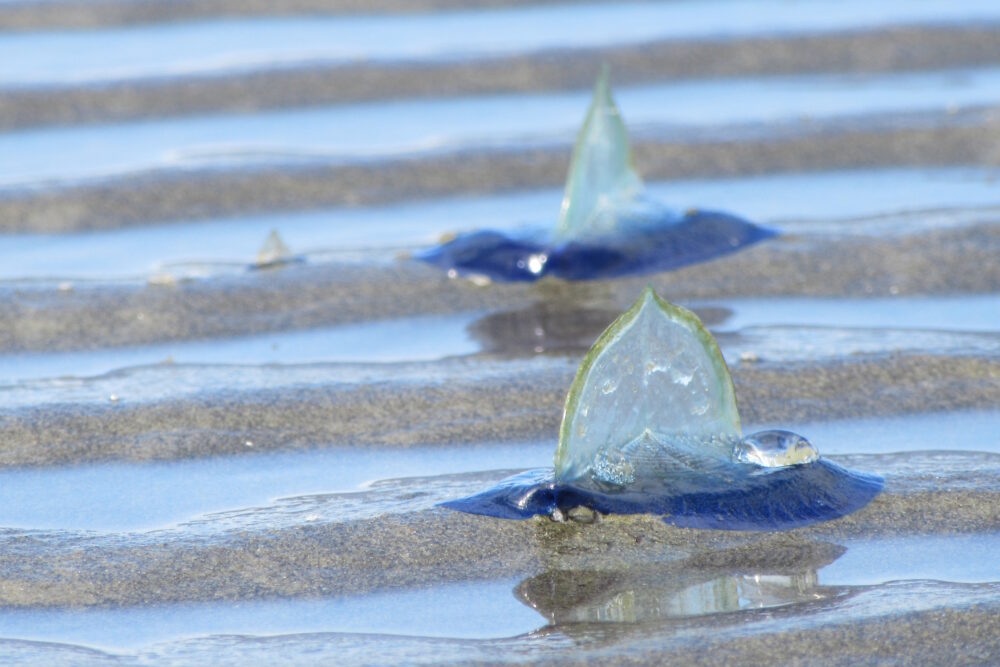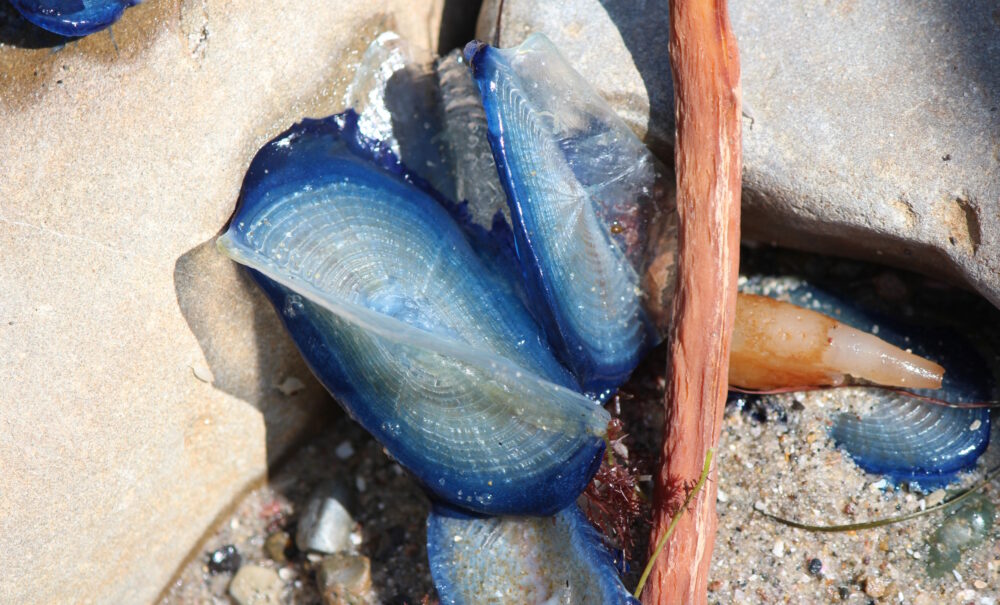Velella, The Little Blue Creatures on California Beaches

Maybe you’ve seen these small blue marine animals that are washing up on California beaches and wonder what they are and where they come from. These little blue creatures that have adapted a natural sail are an organism known as velella velella or simply “velella” and they live on top of the open ocean. The reason you might find them on a beach is that their movements are at the mercy of ocean currents and wind which can blow them ashore.
These unique creatures seem to be spotted on beaches more frequently in recent years and most certainly have found there way onto social media. If you are interested in learning more about velella, see the FAQ (frequently asked questions) below.

- What is velella velella and what makes them unique? Velella, commonly known as “by-the-wind sailor,” is a marine organism that belongs to the phylum Cnidaria, which includes jellyfish, coral, and anemone. They are so unique that they are the only species (velella velella) in their genus (just one “velella”). Though technically they are not a jellyfish, they are similar to a number of “sail jellyfish” that includes the better-known and more dangerous Portuguese Man o’ War. Velella are unique in their appearance, with a flattened, oval-shaped deep blue disc as a base, and a thin translucent membrane rising out of the base that resembles a small sail. This membrane acts as a sail and helps this organism move around the surface of the ocean.
- Where can I see velella? If you haven’t seen one before, your best bet is on a beach after a strong onshore wind. All Northern and Southern California beaches from Oregon to Mexico can have velella, however don’t go looking for them unless you’ve heard reports in the media as their sightings are not predictable. Velella can be found in warm or temperate saltwater ocean waters but unless you have a boat and get lucky, the ocean is not where to look. If velella are near shore during an onshore wind, it is possible to see them at the edge of the surf or on a beach, possibly in mass strandings in the thousands. If stranded on the beach, they will dry up quickly and their light leaf-like bodies will be blown around.
- When can I find velella on a beach? They are most often spotted on California beaches from April to July (peak chance is May and June), but mass strandings have happened before and after these months. They are more likely to be seen on beaches during El Nino years when the surface temperatures of the Pacific Ocean are above average.
- How big are velella? Typically the base of these organisms ranges from 1.5 to 3 inches long (4-8 centimeters). The height of their sail is about 50 percent of the base, so if a velella is two inches long, it would be about one inch tall.
- Are velella dangerous to humans or dogs? Velella are not dangerous to humans. However, if you come in contact with them, it’s a good idea to avoid touching your eyes or mouth, as their tentacles do have toxins and can cause skin and eye irritation. It’s best to keep your pets away from them if they show interest in eating them.
- How do velella move? Velella have air-filled voids in their base and drift on top of the ocean surface by using a small sail that catches the wind. These sails are oriented at an angle, almost 45 degrees, and can have a left or right orientation. A colony of velella will have a mix of opposite oriented sails.
- What do velella eat and how do they obtain their food? Velella are carnivorous and primarily feed on planktonic organisms and the eggs of invertebrates. They capture their prey using tentacles which hang below the water surface by about a 2/5 of an inch (one centimeter). These tentacles are equipped with specialized cells called nematocysts.
- How do velella fit into the marine ecosystem? Velella are carnivores that feed on plankton. They are a food source for other marine organisms, including sea snails and sea slugs.
- What research is currently being done on velella? Current research on velella is focused on their physiology, genetics, and interactions with other marine organisms. Some recent studies have identified unique genes and proteins that may be useful for biotechnology applications.
